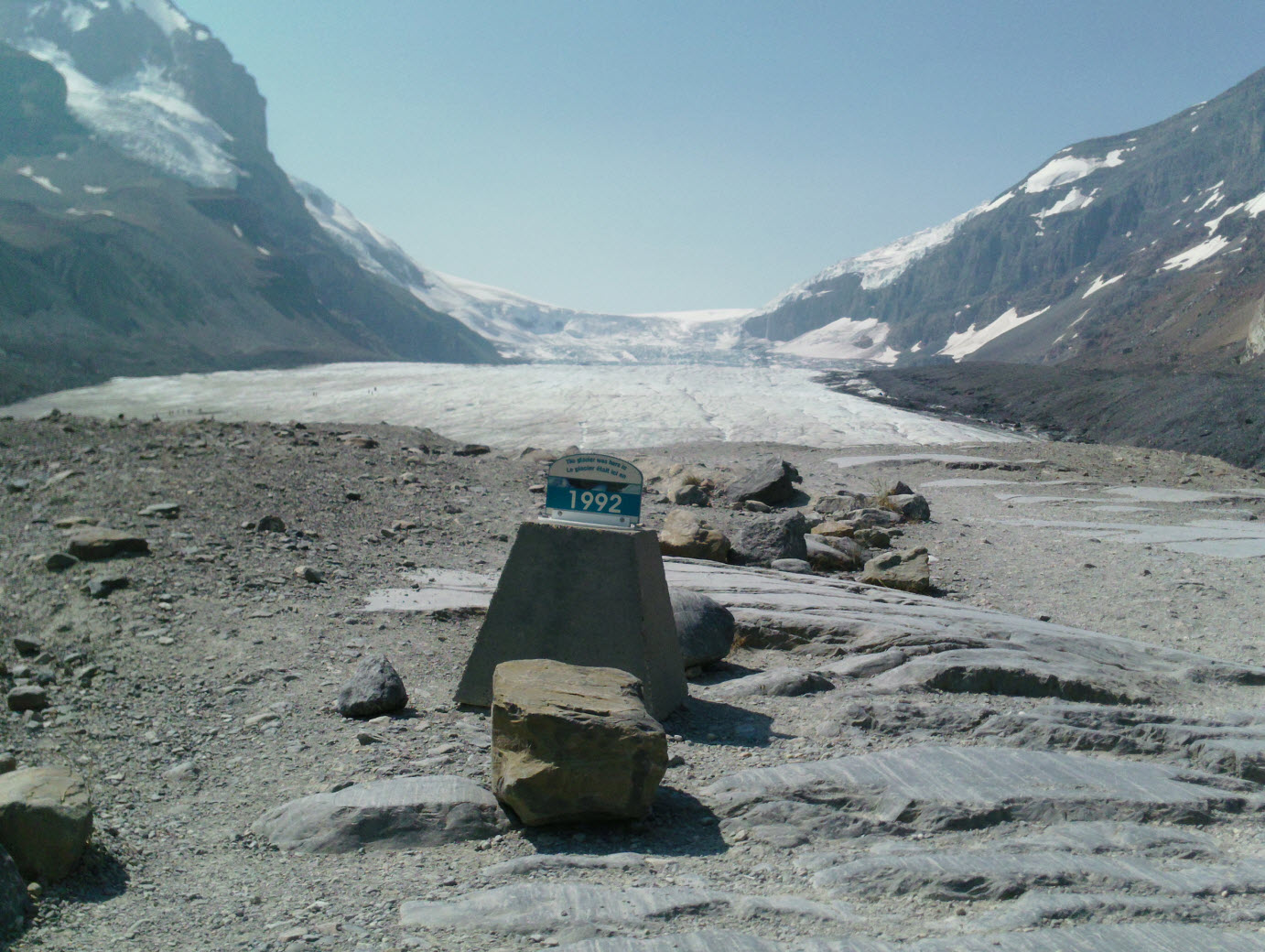
The Athabasca Glacier in the Canadian Rocky Mountains is probably the easiest glacier in the world to access by car. It's just a few hundred metres' stroll from the nearest parking lot on the magnificent Icefields Parkway in Alberta. The problem is, the stroll keeps getting longer by about 10 metres every year. Since 1992, the snout of the glacier has retreated about 200 metres, requiring tourists anxious to set foot on the glacier to walk a little further. The glacier has lost about 2 km of its length since 1844 (Geovista PDF).

The Athabasca Glacier seen from the access trail. This point is about halfway from the parking lot and the current snout of the glacier, which is about 200 metres away. In the centre background is the ice-fall from the Columbia Icefield. The marker shows where the glacier snout was in 1992, coincidentally the year of the Rio Earth Summit. It is just possible to make out some people walking on the glacier on the left-hand side.Click for big.
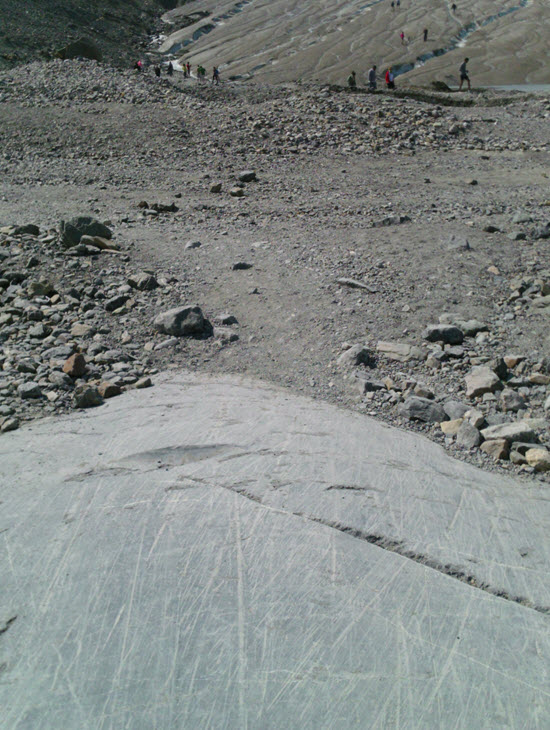
Tourists walking on the glacier snout. Note the striated rocks on the bedrock in the foreground. These striations were caused by rock fragments grinding away at the bottom of the advancing ice through several glacial episodes in the Pleistocene and Holocene. The scratches seen here will likely be the last to form for several tens of thousands years or more.
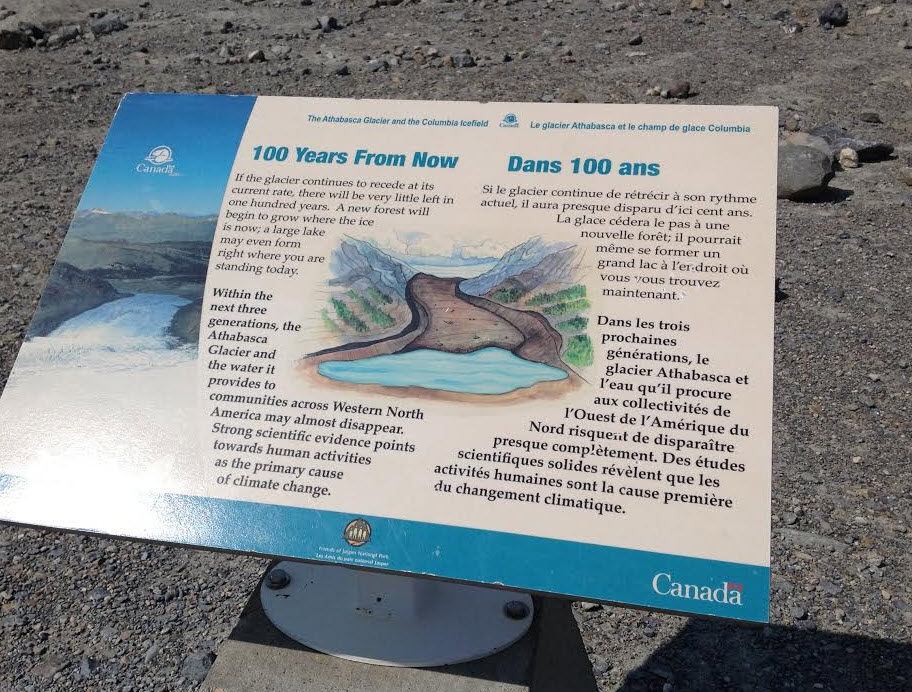
An interpretive sign along the trail to the glacier, by Parks Canada. "Des études scientifiques solides révèlent que les activités humaines sont la cause première du changement climatique." True in both official languages.
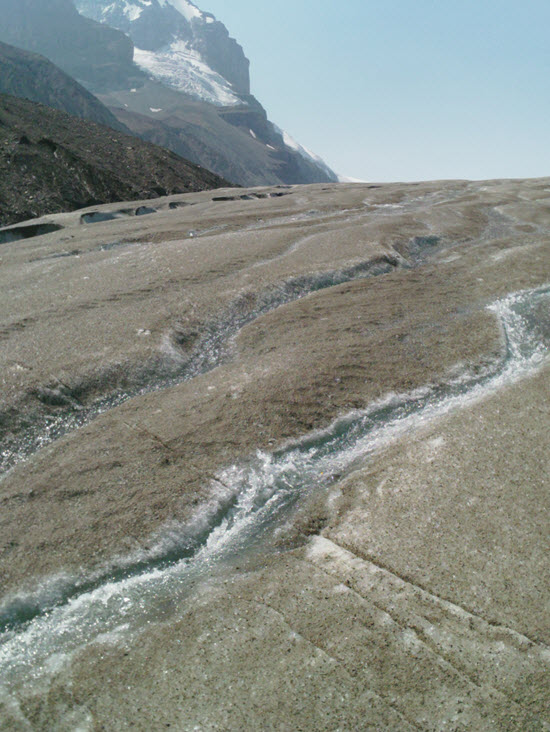
Dirt and rock fragments on top of the ice decrease the albedo of the ice surface, absorbing the August sun. In conjunction with unusually warm summer temperatures, the ice melts quickly.
The meltwater runs down rivulets (about half a metre wide in the photo) on the surface of the ice and down through crevasses to the glacial lake at the snout. The outlet stream of the lake is the source of the Athabasca River, which carves a valley through the mountains and Foothills down to the Great Plains. As it passes through the bitumen deposits of the Athabasca oil sands on its way to the Arctic Ocean, some water is extracted from the river, is superheated by natural gas and injected into the bituminous sandstones to melt the bitumen so that it can flow into well bores and be pumped to the surface. The bitumen is refined to gasoline with the help of more natural gas and is then used, in part, to fuel vehicles that ferry visitors to the Athabasca Glacier. The emissions from these vehicles contribute to the greenhouse gases that are melting the glacier. And so the Anthropocene resource cycle continues, at least for a while longer.
Of course, the Athabasca Glacier is not unique. Most glaciers are rapidly disappearing all over the world. According to Chapter 13 of the latest IPCC report (big PDF) melting glaciers will make up about a quarter of the increased volume of the rising oceans over the rest of this century and about half of the increase in ocean mass. Approximately half of the increase in volume will come from expansion of seawater as it warms. About half of the increase in mass will come from melting of the Antarctic and Greenland ice sheets (counted separately from the mountain glaciers) and from changes in land storage of water. See Table 13.5 for details.
One of the main references used for the IPCC report was a 2012 paper in The Cryosphere by Marzeion, Jarosch and Hofer (open access PDF). They measured and modelled glaciers in several regions around the world and projected glacier melting under the Representative Concentration Pathways (RCP). For RCP 2.6 (the low-emissions pathway), glaciers will contribute 125mm (63-181) to sea-level rise (SLR); for RCP 8.5 (the high-emissions pathway), 185mm (95-255).
The contribution from different glaciated regions for the two extreme emissions scenarios is shown in the figure below.
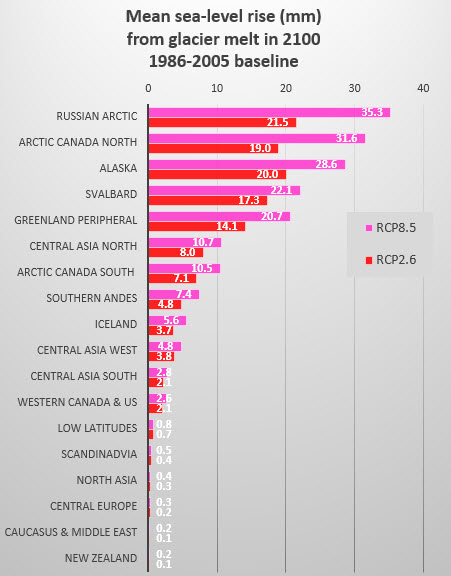
Based on numbers kindly provided by Ben Marzeion. The definition of the regions is shown in this figure.
What is striking is the relatively small difference in most cases in the amount of SLR from glacier melt to 2100 in the two very different RCP scenarios. Part of this is because of the long lag time of glacier response to existing human and natural climate change. We are therefore already locked in to significant glacier ice loss, no matter what we do with emissions over the next few decades. This is particularly true for mountain glaciers in tropical and temperate latitudes.
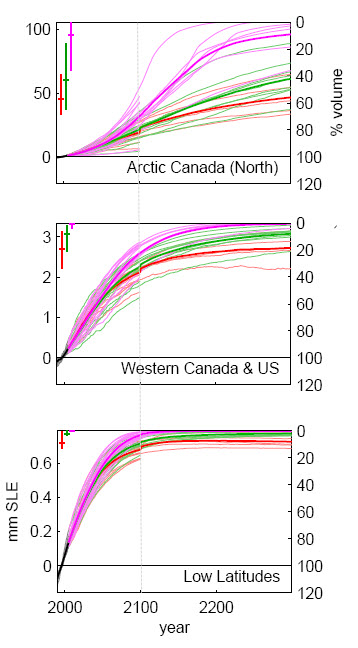
Three regions selected from Figure 23 of Marzeion et al (2012), show mass balance of glaciers out to 2300. The red lines are model runs for RCP 2.6, green for 4.5 and pink for 8.5. "Western Canada & US" excludes Alaska and the Canadian Arctic. "Low Latitudes" includes all of the tropical glaciers of South America, Africa and Indonesia. The amount of sea-level equivalent rise is shown on the left axis and the right axis shows the percentage of ice remaining, relative to a 1986-2005 baseline.
Note that ~80% of the low-latitude ice is gone by 2100 under any scenario. For Western Canada and the US ~60% of the ice will melt under pathway RCP 2.6 and ~80% under RCP 8.5 by 2100. The Arctic glacier ice is more resilient (and voluminous), but even so, more than half of it will melt by 2300. Even if we manage to limit warming to 2°C, we have already locked in the eventual loss of the bulk of the planet's glaciers.
Glaciers have been observed to be shrinking since the middle of the nineteenth century, long before human-caused climate change became significant. Leclercq et al. (2011) showed that glaciers started melting around 1850 and that the rate of mass loss has remained fairly constant (about 150-400 billion tonnes of water per year according to Figure 4.12 in the IPCC AR5 report Chapter 4) from then until the present day. The world seems to have hit "peak glacier" around 1850 and the loss of glacier ice since then has added roughly 10 cm to global sea levels.
A recent paper by Marzeion et al (2014) in Science (paywalled) attempts to unravel the natural and human contributions to glacier melt. They calculated that without human influences, glaciers would have added 9.9 cm (±3.6) and that with human activities included the figure is 13.3 cm (±3.0). The percentage of human influence varies over time, as shown in the figure below.

Part of Figure 1 from Marzeion et al. (2014), showing the increasing anthropogenic influence on glacier melt. The blue line is the running 20-year mean of the model ensemble and the shaded blue area is the standard error.
What these results show is that glacier melt was almost exclusively natural up to 1920, after which time the human influence rose steadily as the effects of human-caused climate change started to increase and the natural climate changes resulting from recovery from the Little Ice Age diminished. Currently, the human contribution to glacier melt is about two-thirds (69 ±25%). Through the rest of the 21st Century, the human contribution to the melting of glaciers is expected to increase even more.
The glaciers of the temperate and low latitude mountain ranges in the Rockies, the Andes, Alps, Pyrenees, Caucasus, Scandinavia, the African Rift, Indonesia and the Southern Alps are disappearing fast and will be mostly gone by 2100, no matter what we do with future emissions. Even the glaciers of the mighty mountains of South Central Asia, the so-called third pole, will be more than half gone in just a few generations. There is still hope to save about half of the volume of the huge glaciers and icecaps of Alaska and the Arctic provided that we follow a prudent emissions pathway.
A lunch break on a hike in the Spanish Pyrenees (in 2002). The glaciers in the background on the right are the Aneto and Maladeta glaciers, the largest in the Pyrenees, likely to disappear altogether by mid-century.
Putting aside, for now, the consequences for human and ecological welfare as the glaciers retreat and no longer provide steady water supplies through the summer, the imminent loss of the glaciers in the world's temperate and tropical mountains is a terrible blow to those of us who treasure the mountains for their cultural, recreational and aesthetic value. The glaciers we marvel at will soon be gone and they won't be coming back on any imaginable human timescale. It's a damned shame.
Gadd, B. (2011) Athabasca Glacier and Columbia Icefield GeoVistas Brochure,published by the Canadian Federation of Earth Sciences. PDF
Leclercq, P. W., J. Oerlemans, and J. G. Cogley. "Estimating the glacier contribution to sea-level rise for the period 1800–2005." Surveys in geophysics 32.4-5 (2011): 519-535. PDF
Marzeion, Ben, A. H. Jarosch, and Marlis Hofer. "Past and future sea-level change from the surface mass balance of glaciers." The Cryosphere Discussions 6.4 (2012): 3177-3241. PDF
Marzeion, Ben, J. Graham Cogley, Kristin Richter and David Parkes "Attribution of global glacier mass loss to anthropogenic and natural causes" Science 1254702 (2014) [DOI:10.1126/science.1254702] Abstract (paywalled)
Posted by Andy Skuce on Tuesday, 26 August, 2014
 |
The Skeptical Science website by Skeptical Science is licensed under a Creative Commons Attribution 3.0 Unported License. |